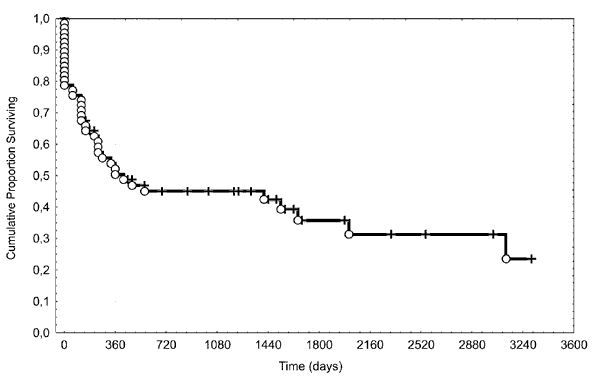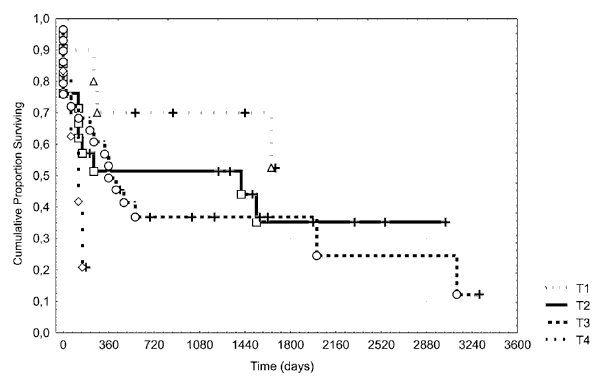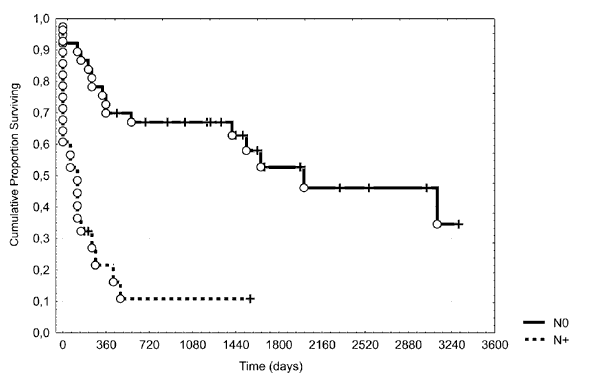

Year: 2004 Vol. 70 Ed. 6 - (8º)
Artigo Original
Pages: 773 to 776
Treatment of squamous cell carcinoma of soft palate
Author(s): Ali Amar , Otávio Alberto Curioni1, Sérgio Altino Franzi1, Josias Andrade Sobrinho1, Abrão Rapoport1
Keywords: Key words: squamous cell carcinoma, soft palate.
Abstract:
Summary
Objective: To evaluate the results of the treatment of squamous cell carcinoma of the soft palate. Study Design: Retrospective case-series. Material and Method: Retrospective review of the files of 111 patients with squamous cell carcinoma of the soft palate treated between 1977 and 2000. Sixty-six patients with follow up after the treatment were selected, being appraised the loco-regional control and the disease-free survival according to the stage. Results: Radiotherapy presented complete response in the primary site in 76% of the patients and in the neck in 47% of the N+ patients. Considering the recurrences, the control in both sites were 52% and 31% respectively. The cervical recurrences occurred in 11% of irradiated N0 patients and in 28% of the T1 surgical cases without neck treatment. The disease free survival at 3 and 5 years was 45% and 35% respectively, being significantly minor in N+ patients. Conclusion: The persistence or neck recurrence is the main cause of failure in the exclusive irradiated cases. Even the T1 lesions present high incidence of lymph node metastases, justifying the elective neck dissection.
![]()
Introduction
Soft palate neoplasia is a condition infrequently observed, once studies that evaluate this specific anatomical site alone are rare; they are rather investigated along with other pharyngeal sub-sites. Squamous cell carcinoma is a predominant histological type, which presents high incidence of second primary tumor associated with tumors of this site, either synchronous or metachronous1. The soft palate plays an important role in both swallowing and phonation, what makes rehabilitation difficult and determines radiotherapy as tumor treatment of choice, according to several publications2-6. Notwithstanding, soft palate tumors usually present early lymph node involvement - frequently bilateral - where radiotherapy is not sufficient to control the disease7. The present study assessed the results of the treatment chosen for patients with squamous cell carcinoma of the soft palate.
Material and Method
In this retrospective study, case records of 111 patients with squamous cell carcinoma of the soft palate admitted to Hospital Heliópolis in the period of October 1977 and December 2000 were revised. For assessing treatment results, 12 patients (10%) - who simultaneously presented a second primary tumor -, and 33 patients - who have not returned after the initial examination - were excluded, leaving a total of 66 patients. Out of those, 58 subjects (87%) were followed up for over 18 months or until recurrence was diagnosed. There were 56 men and 10 women and mean age was 58 years (15 to 100). Patients were restaged according to 2002 UICC TNM Classification, while the Kaplan-Meier actuarial method was applied for survival analysis and differences among the groups were evaluated by the log-rank test (p<0.05 accepted).
Results
Forty-six patients received radiation therapy. The mean dosage applied was 72Gy in opposite parallel fields. Complete response was observed in 31 patients (67%). The end of treatment observed full response at the primary site in 35 patients (76%) [1/1 T1, 11/13 T2, 20/26 T3, 3/6 T4]. Out of 35 subjects who fully responded to radiation at the primary site, 14 presented local recurrence within an 8-month interval. Three of them were rescued with success, out of which 1 was T2 and 2 were T3. As to recurrences and rescues, primary tumor control was reached in 52% of the cases - 1/1 T1, 9/13 T2, 12/26 T3 and 2/6 T4. Nineteen patients presented cervical metastases and 9 (47%) had full response in the neck. Out of those, 3 showed regional recurrence, among which 1 had previous history of local recurrence. Cervical control was achieved in 31% of N+cases. Out of 27 N0 patients, 3 (11%) had cervical recurrences - 1 case of simultaneous recurrence and 1 whose diagnosis was after recurrence of primary tumor. Local regional control, according to TN staging is shown on Table 1.
The group of patients submitted to surgery was heterogeneous. Twelve patients underwent resection of the primary tumor, out of which 2 had associated neck dissection. Local recurrence was diagnosed in 2 patients in the first year after treatment and 3 patients had recurrences in the primary site in a period between 51 and 101 months from initial treatment. Seven T1N0 patients underwent resection of the primary tumor of non-treated neck, among which, 2 developed regional recurrence with successful recovery. Eight patients underwent surgical treatment of the cervical metastasis. Out of those cases, 2 had radical neck dissection and six went through lymphadenectomy followed by radiotherapy. There was 1 post-operative death and 2 patients were lost for follow up. Only 1 patient had the disease controlled after 13 months.
Three and five-year disease-free survival was observed in 45% and 35% of the cases, respectively (Figure 1). No significant differences were found in T patients (Figure 2) compared to T2-T3 subjects (the majority), once they presented similar results. Consistent reduction of 5-year disease-free survival rates (Figure 3) were related to presence of node involvement - 53% and 11% for N0 and N+ patients, respectively (p=0.00004).
Discussion
Radiotherapy has been the treatment of choice for neoplasias of the soft palate, as there are several difficulties for patients' reconstruction and rehabilitation due to the muscular structure of this anatomical region. On the other hand, high incidence of nodal metastases reveals that radiotherapy is not sufficient to control the disease7. Among N+ patients, regional control was reached in 31% of the cases, which is similar to false-positive rates observed in cases of neck dissection. In N0 cases, despite the expected high rate of occult metastases, regional recurrences were observed in only 1 patient and were suggestive of the radiotherapy effect on sub-clinical neck disease. Concerning the primary site, radiotherapy resulted in full response in 76% of the cases, although 40% of those had disease recurrence after an average interval of 8 months.
Treatment of soft palate tumors should include not only radiotherapy, but also strategies for organ preservation. In case of no responses to radiotherapy at the primary site and neck, as well as of recurrence salvage, conservative surgical treatment should be considered.
Neoadjuvant chemotherapy to select patients for organ preservation may be disregarded in tumors of the soft palate, once the results of radiotherapy may be more easily followed in this site as compared to sites such as the larynx and hypopharynx.
Patients with extensive disease could be benefited by this modality but, so far, only concomitant chemotherapy has demonstrated to control local-regional disease8,9. Another prognostic indicator is the response obtained at the primary site during radiation therapy. Jaulerry et al. have observed that response lower or equal to 50% at the primary site after 5 weeks of radiotherapy (55Gy) - especially among patients with extensive primary tumors (T3 and T4) - was related to low probability of disease control10. Therefore, in operable cases with no good response to treatment, surgical rescue may be anticipated. Following disease control at the primary site, neck evaluation should be performed 3-4 weeks after conclusion of radiotherapy, and computerized tomography is indicated11. Once full response is obtained, neck dissection of initial N1 cases is not necessary. For N3 neck cases, despite full response (not common in this stage), neck dissection is indicated, as 50% of those patients may present residual tumor, cases in which the disease is frequently unresectable12. Although planned dissection of N2 neck is indicated, this stage includes a great variety of clinical presentations, from bulky (between 3.1cm to 6cm in diameter) or multiple lymph odes up to small bilateral or contralateral lymph nodes. In summary, the presence of nodal metastases signalizes very poor prognosis, which is related not only to regional disease control, but also to higher recurrence rate at the primary site and to distant metastases.
For initial tumors, surgery may offer lower morbidity than high dosage irradiation of the pharynx. It should be emphasized that irradiation, associated with the damage caused by the tumor, also leads to organ or structure's functional deficit. Concerning the surgical treatment, the incidence of cervical metastases is relevant, even in initial tumors - 40% of T1 cases13. Moreover, soft palate tumors may require bilateral treatment of the neck in case of midline lesions. In this study, 28% of patients with T1N0 primary tumors who did not undergo neck treatment, presented cervical recurrence. Even though they have all been successfully salvaged, incidence of occult metastases justifies the elective treatment of the neck. In larger tumors that may require full resection of the soft palate for adequate margins, a conservative procedure should be tried.
Studies presenting assessment of life quality after radiotherapy or surgery in this group of patients are not available. However, total reconstruction of the palate is technically very difficult and offers modest results, even when prostheses are used.
Although development of a second primary tumor is frequent among patients with squamous cell carcinoma of the upper aerodigestive pathways, most are metachronous tumors, whereas in the soft palate a great number of simultaneous tumors is found, which reinforces the importance of the malignization field concept14.
Table 1. Local-regional control after radiotherapy, according to stages T and N.
Figure 1. Disease-free survival of squamous cell carcinoma of the soft palate (n=66).
Figure 2. Disease-free survival according to stage T (n=66).
Figure 3. Disease-free survival and nodal metastases (n=66).
References
1. Point D, Rodriguez J, Ferrante B, Brugere J. Cancers du voile du palais: Rèsultats de la chirurgie de rattrapage. Ann Otolaryngol Chir Cervicofac 1987; 104:395-7.
2. Martin H. Tumors of the palate (benign and malignant). Arch Surg 1942; 44:599-635.
3. Mendenhall WM, Amdur RJ, Stringer SP, Villaret DB, Cassisi NJ. Radiation therapy for squamous cell carcinoma of the tonsillar region: a preferred alternative to surgery? J Clin Oncol 2000; 18:2219-25.
4. Fee WE, Schoeppel SL, Rubenstein R et al. Squamous cell carcinoma of the soft palate. Arch Otolaryngol 1979; 105:710-8.
5. Horton D, Tran L, Greenberg P, Selch MT, Parker RG. Primary radiation therapy in the treatment of squamous cell carcinoma of the soft palate. Cancer 1989; 63:2442-5.
6. Tandon DA, Bahadur S, Rath GK. Carcinoma of the soft palate. J Laryngol Otol 1992; 106:130-2.
7. Erkal HS, Serin M, Amdur RJ, Villaret DB, Stringer SP, Mendenhall WM. Squamous cell carcinomas of the soft palate treated with radiation therapy alone or followed by planned neck dissection. Int J Radiat Oncol Biol Phys 2001; 50:359-66.
8. Machtay M, Rosenthal DI, Hershock D et al. Organ preservation therapy using induction plus concurrent chemoradiation for resectable oropharyngeal carcinoma: A University of Pennsylvania phase II trial. J Clin Oncol 2002; 20:3964-71.
9. Denis F, Garaud P, Bardet E et al.. Final results of the 94-01 French Head and Neck Oncology and Radiotherapy Group randomized trial comparing radiotherapy alone with concomitant radiochemotherapy in advanced-stage oropharynx carcinoma. J Clin Oncol 2004; 22:69-76.
10. Jaulerry C, Dubray B, Brunin F et al. Prognostic value of tumor regression during radiotherapy for head and neck cancer: a prospective study. Int J Radiat Oncol Biol Phys 1995; 33:271-9.
11. Ojiri H, Mendenhall WM, Stringer SP, Johnson PL, Mancuso AA. Post-RT CT results as a predictive model for the necessity of planned post-RT neck dissection in patients with cervical metastatic disease from squamous cell carcinoma. Int J Radiat Oncol Biol Phys 2002; 52:420-8.
12. Mabanta SR, Mendenhall WM, Stringer SP, Cassisi NJ. Salvage treatment for neck recurrence after irradiation alone for head and neck squamous cell carcinoma with clinically positive neck nodes. Head Neck 1999; 21:591-4.
13. Har-El G, Shaha A, Chaudry R, Hadar T, Krespi YP, Lucente FE. Carcinoma of the uvula and midline soft palate: indication for neck treatment. Head Neck 1992; 14:99-101.
14. Slaughter DP, Southwick HW, Smejkal W. Field cancerization in oral stratified squamous epithelium. Cancer 1953; 6:963-8.
----------------------------------
1 Surgeon, Department of Head and Neck Surgery and Otorhinolaryngology, Hospital Heliópolis, Hosphel. Sao Paulo, Brazil.
Study conducted at the Department of Head and Neck Surgery and Otorhinolaryngology, Hospital Heliópolis, Hosphel. Sao Paulo, Brazil.
Address correspondence to: Rua Iramaia, 136 Jd. Europa Sao Paulo 01450-020
E-mail: arapoport@terra.com.br



